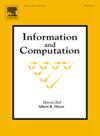非决定论和集团问题
IF 1
4区 计算机科学
Q3 COMPUTER SCIENCE, THEORY & METHODS
引用次数: 0
摘要
已知团问题是NP完全的,而P是否=NP的问题尚未解决。本文考察了非决定论与决定论在有限条件下的相对权力。具体来说,我们考虑用非确定性图灵机和确定性图灵机来求解团问题。我们使用一种(合理的)格式对问题实例进行编码。我们还对确定性图灵机和非确定性图灵机的计算施加了约束:两者都有两个磁带,输入磁带是只读的和单向的,一旦达到输入磁带的某个停止点,就不允许在工作磁带上进行额外的写入。对于停止点的位置,我们考虑了两种情况:在指定了图节点的数量和团的大小之后,或者由参数q控制,该参数q表示已经扫描了图节点的边缘规格的哪一部分。参数q可以任意接近1,例如q=0.99999。我们表明,在我们的设置中,对于这两种情况,非确定性图灵机可以在O(n3)时间内解决问题,而确定性图灵机无法在多项式时间内解决问题。然而,我们展示了一个指数时间确定性的单工作带,双头图灵机,解决了我们设置中的团问题。本文章由计算机程序翻译,如有差异,请以英文原文为准。
Nondeterminism and the clique problem
The Clique problem is known to be NP-Complete and the question whether P=NP is unresolved. This paper examines the relative power of nondeterminism versus determinism in a restricted setting. Specifically, we consider solving the clique problem using non-deterministic and deterministic Turing machines. We impose a (reasonable) format in which a problem instance is encoded. We also impose constraints on the computation of both deterministic and non-deterministic Turing machines: both have two tapes, the input tape is read-only and one-way, and once a certain stop point in the input tape is reached, no additional writing on the work tape is allowed. We consider two cases for the position of the stop point: immediately after the number of graph nodes and the size of the clique are specified, or controlled by a parameter q that indicates what portion of the graph nodes' edge specifications have been scanned. The parameter q may be arbitrarily close to 1, e.g., . We show, for both cases in our setting, that a non-deterministic Turing machine can solve the problem in time whereas no deterministic Turing machine can solve the problem in polynomial time. However, we exhibit an exponential time deterministic single work tape, two-heads Turing machine that solves the clique problem in our setting.
求助全文
通过发布文献求助,成功后即可免费获取论文全文。
去求助
来源期刊

Information and Computation
工程技术-计算机:理论方法
CiteScore
2.30
自引率
0.00%
发文量
119
审稿时长
140 days
期刊介绍:
Information and Computation welcomes original papers in all areas of theoretical computer science and computational applications of information theory. Survey articles of exceptional quality will also be considered. Particularly welcome are papers contributing new results in active theoretical areas such as
-Biological computation and computational biology-
Computational complexity-
Computer theorem-proving-
Concurrency and distributed process theory-
Cryptographic theory-
Data base theory-
Decision problems in logic-
Design and analysis of algorithms-
Discrete optimization and mathematical programming-
Inductive inference and learning theory-
Logic & constraint programming-
Program verification & model checking-
Probabilistic & Quantum computation-
Semantics of programming languages-
Symbolic computation, lambda calculus, and rewriting systems-
Types and typechecking
 求助内容:
求助内容: 应助结果提醒方式:
应助结果提醒方式:


